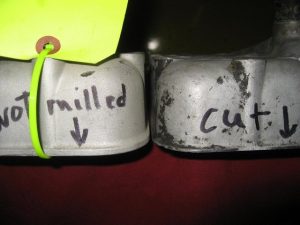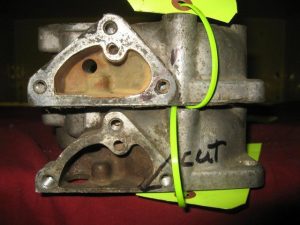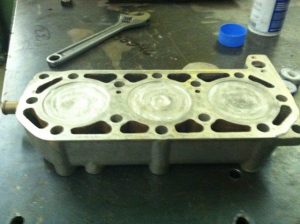I do not know if any of you are like me or not but when I pickup a used Saab two stroke head I always wonder how much has been milled off of it, or if it is still at the original OEM factory thickness. As we all know, the more someone has milled off a head the bigger chance you have for detonation and piston melting. (or the faster it will run till it blows!) Which begs the question…”What is OEM thickness of the two stoke heads) Non 92’s). Not being able to source this old info I decided to do some head checking of my own. So I loaded my trusty 9000 trunk up with 40 plus old two stroke heads (photo #1) and took them into town to my shop were I could measure and document them better. I even had a few NOS heads! So armed with that many heads it was kind of easy to see where the OEM head started out life. If you measure the total thickness of the head (from the head gasket surface to the flat area the head bolt washers flatten onto) you will see the original thickness is 2.280″ (+/- .010″). (Photo #2)
You will find many heads roughly .005″ to .010″ less than this stock thickness from being milled flat to eliminate warping or for a better head gasket fit through the years. This is fine but be sure the “SQUISH AREA” of about .029″ has been re-machined into the head. No squish area can lead to detonation real fast. (I have more about this on my youtube channel and website)
This stock head thickness of 2.280″ is good for all 750, 750GT, 850 and 850GT heads (both Bullnose and Longnose). With this measurement it is easy to figure out how much has been milled off the head you have in your hand. Actually you can even SEE the difference in a Bullnose car with a little close looking. If you look at the tapered area of the head were it widens for the head gasket (photo # 3) you can see how much of it is left if you have another to compare too. As you mill the head, this area ends up on the shop floor! Look at a few and you will see what I mean.
On a longnose the area that is easy to tell is the water pump lower lip area, (photo #4). The bottom edge where the gasket seals to the head gets REAL THIN as you mill the head down. This should be about .250″ thick on a virgin unit but as it gets thinner your chances of coolant leakage increase. Be sure to tell your machine shop to NOT cut this area to prevent ruining it. (We can fix it if they do 🙂
BTW…we do all sorts of Saab engine milling in our shop for those interested. And also any issue with your head we can repair now….stripped spark plug & temp sender threads (we have the “TIME-SERT” repair kits), damage from previous meltdown, and so on. Do not throw any of them away!
It is pretty common to see heads that have .140″ milled off them (3.5mm). So if you head measures 2.140″ (2.280″ minus .140″ equals 2.140″ (+/- .010″) that is were the metal went!
You will also see a few that have .180″ milled off (4.5mm which is Saab Stage III on non GT/MC heads). So if you have a 2.100″ thick head, that is what she is! (2.280″ – .180″ = 2.100″ (+/- .010″).
NOTE: (You can not take as much metal off an already “from the factory” higher compression head like a GT or MC without shooting your compression ratio too high!)
If I remember right (and my memory is not as good today) some guys in Sweden claim they can cut off as much as .280″ off on CERTAIN brands/models of heads before they are too weak to function. We have taken a different approach here in Fort Dodge on our racing applications two stroke engines. We actually start with a common STANDARD head and then spray the chamber full of aluminum and start over with a total “re-bore” of the combustion chambers. (Photo #5) This allows us to get REAL radical with design and CC area of the chamber. We can do this work for you too if you like. Just remember…the smaller you make the chamber, the less CC’s of air it will hold and your compression ratio will really start to jump up. Once you get over 10 to 1 ratio (10/1) things get a little dicey and should only be used on the race track (or near your repair shop!)
So there you go with a little more info than you started with hopefully. Grab some heads and measure away! The more you look, the more you will lean. And, just maybe, you will see why that one engine “keeps blowing up!” or “seems to run better” than the others!
And if you do run a head that has been milled a bunch you can still be safe by dropping you timing down a bit and and/or running high octane fuel!
I also have a video on YOUTUBE describing and showing all of this head info as well as many other “How to” videos on youtube.com for you to view. (my username is “donneysaab”)
My website also has these “Tech Tips” too at www.tomdonneymotors.com
Thanks for reading and safe Saab’in! Tom Donney
tomsaab@gmail.com or cell 515-368-7222 for quesitons






Leave A Comment